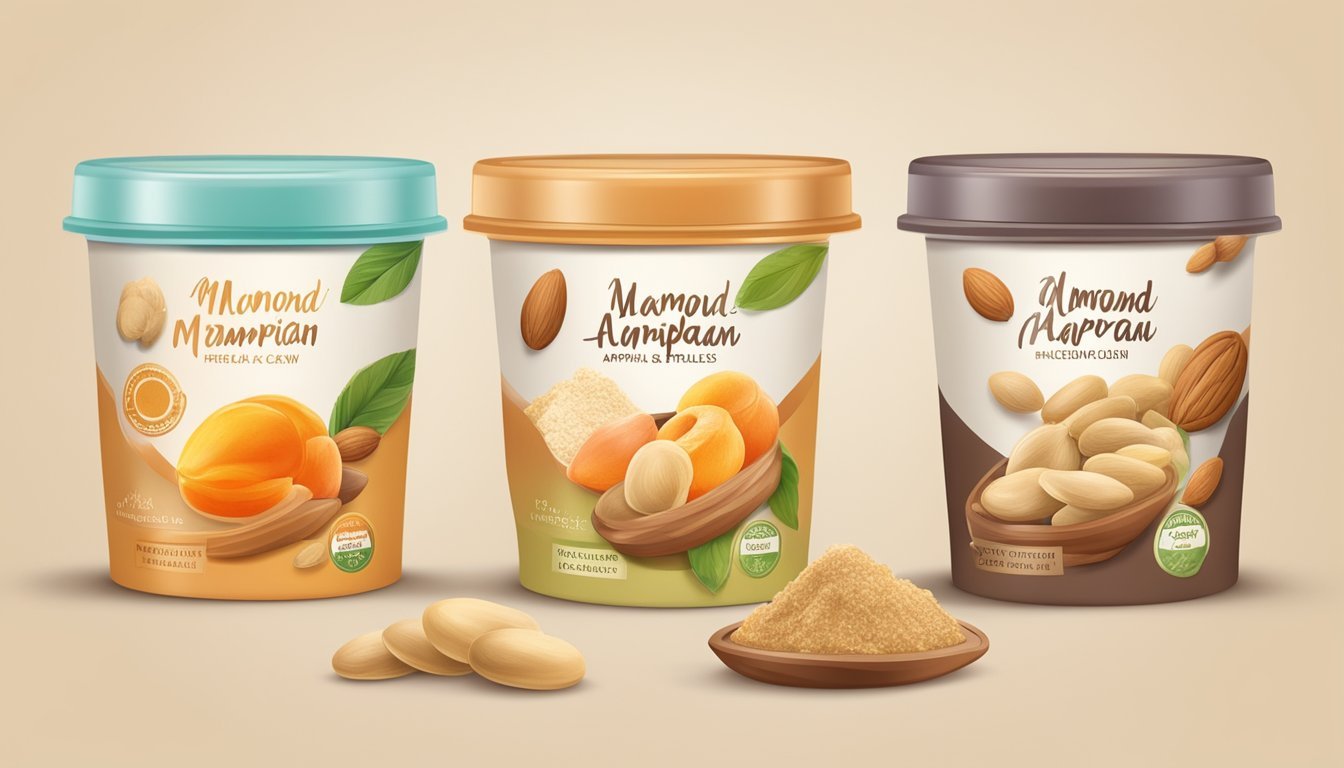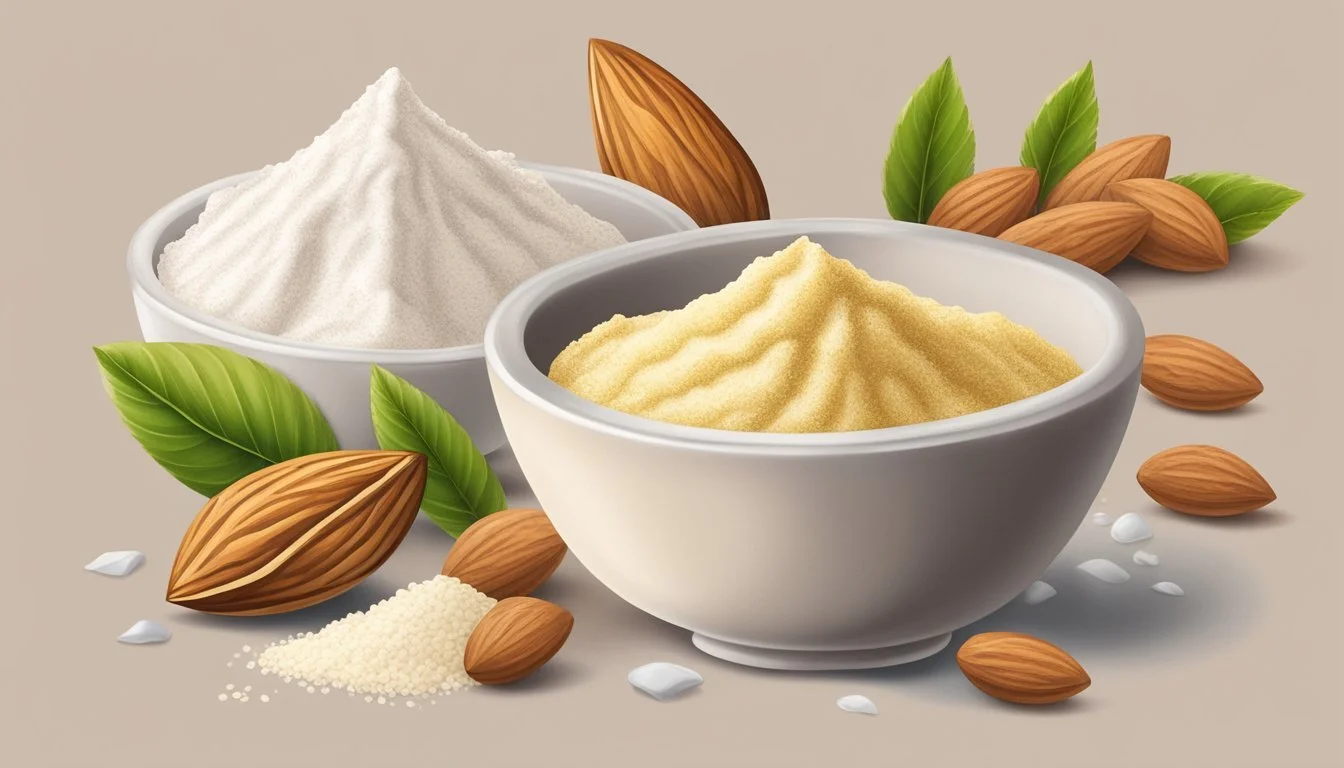Almond Paste or Filling Substitutes
Top Alternatives for Baking
Almond paste, a key ingredient in many baked goods and confections, is prized for its smooth texture and rich, nutty flavor. Typically composed of ground almonds, sugar, and some binding agent like egg whites or oil, almond paste adds moisture and depth to a variety of sweet treats. It is distinct from almond filling, which may contain almond paste but often consists of additional ingredients to create a ready-to-use mixture for stuffing pastries and other desserts.
With dietary restrictions, nut allergies, or simply a shortage in the pantry, bakers and cooks may need to find suitable substitutes for almond paste that still uphold the integrity of their dishes. A variety of alternative ingredients can be employed to mimic the flavor and function of almond paste in recipes. These substitutes include marzipan, which is sweeter, as well as options like almond butter, almond flour, and various nut-free alternatives, which can be adjusted in sweetness and texture to come close to the original.
When selecting a substitute for almond paste, it's essential to consider the desired outcome in terms of flavor, texture, and sweetness. Substitutes like marzipan will require adjustments to sugar content in the original recipe, while almond butter provides a similar nuttiness with a potentially different texture. Homemade solutions can also be crafted by combining ground nuts or nut-free options with sweeteners and binding ingredients to achieve a close approximation to the original almond paste.
Understanding Almond Paste
Almond paste acts as a cornerstone ingredient in many baking recipes due to its rich flavor and versatile texture. It combines ground almonds and sugar to achieve its distinctive taste and consistency.
Composition and Uses
Almond paste is a mixture composed primarily of ground almonds and sugar, typically forming about a 50:50 ratio. In some cases, additional ingredients such as almond extract or preservatives are included to enhance flavor or extend shelf life. It holds a prominent place in the culinary world, being used for:
Filling for pastries and pies
Ingredient in cookies and cakes
Base for confectionery decorations
It's lauded for both its adaptable texture, which ranges from soft to firm depending on preparation, and for its intense almond flavor that enriches the overall taste profile of any dessert.
Nutritional Profile
Almond paste offers a nutritional profile that includes protein and fiber from the almonds. A rudimentary breakdown for a general almond paste composition is as follows:
Nutrient Content Protein Moderate Fiber Moderate Sugar High
It's important to note that while almond paste contributes protein and fiber, it is also high in sugar, making it a concentrated source of energy. Moderation is advised when considering its nutritional implications in a diet.
Commercial Almond Paste Alternatives
When seeking alternatives to almond paste in commercial baking, one should consider factors such as sugar content, flavor profile, and consistency. Two well-known substitutes are marzipan and persipan, each offering distinct qualities that suit different types of recipes.
Marzipan Comparison
Marzipan is closely related to almond paste but differs significantly in sugar content. Typically, marzipan contains 75% to 85% sugar, while almond paste has closer to 50%. When using marzipan as a substitute:
Reduce the sugar in the recipe by approximately 20%.
Marzipan offers a sweeter and smoother texture, which may affect the outcome of the baked goods.
Almond Paste Marzipan 50% sugar 75%-85% sugar Less sweet Significantly sweeter Coarser texture Smoother texture
Marzipan's intense sweetness is complemented by components like almond extract or vanilla, producing a nuanced flavor profile.
Persipan: The Apricot Option
Persipan is a lesser-known but effective almond paste substitute derived from apricot kernels or peach kernels. Its similarities to almond paste in terms of texture make it a practical replacement in baking. Key attributes of persipan include:
Lower almond flavor intensity, imparting a subtler taste.
Persipan is often used in scenarios where almond allergies are a consideration.
Like with marzipan, it is essential to adjust the sugar levels in the recipe, as persipan may be sweeter than traditional almond paste.
Persipan's unique flavor is often preferred in specialty pastries and can be enhanced with vanilla to balance the taste.
Homemade Substitutes for Almond Paste
Creating substitutes for almond paste at home is feasible with common pantry ingredients. These alternatives can be tailored for specific dietary needs or preferences, whether one desires a nutty flavor or requires a nut-free option.
Using Nut Butters
Nut butters, like almond butter or cashew paste, can mimic the consistency and flavor profile of almond paste. To replicate the texture of almond paste, one may blend nut butter with equal parts sugar until the desired sweetness and consistency are achieved.
Almond Butter: Combine with confectioner's sugar; use a 1:1 ratio for a spreadable consistency.
Cashew Paste: Blend cashews with a touch of oil and sweeten to taste for a smooth paste.
Nut-Free Alternatives
Those with nut allergies can employ nut-free options like chestnut puree or pumpkin seeds to create a substitute for almond paste.
Chestnut Puree: Sweeten chestnut puree to use as a stand-in, especially in baked goods.
Pumpkin Seeds: Grind into a fine powder and mix with sugar to form a paste resembling almond paste in texture.
Using Seeds
Seed-based pastes present another versatile option for imitating almond paste, particularly for individuals with nut sensitivities.
Pumpkin Seeds: Ground pumpkin seeds combined with sugar can approximate the texture of almond paste and offer a distinctive taste.
Each of these homemade substitutes can serve as a replacement for almond paste in many recipes, providing similar textures and flavors. They also offer customization for those seeking to control the sugar content or avoid nuts due to allergies or personal preferences.
Texture and Flavor Adaptations
When creating substitutes for almond paste or filling, one must pay careful attention to achieving a similar consistency and flavor profile to ensure the desired outcome in recipes. These adaptations will guide cooks in selecting the best alternative ingredients for successful culinary creations.
Achieving Similar Consistency
Almond paste has a unique, semi-firm texture that lends itself well to baked goods and confections. To mimic this consistency, one may utilize:
Almond Flour: Offers a fine texture that can help recreate the smoothness of almond paste when combined with a binding agent such as egg whites or simple syrup.
Almond Meal: While coarser than almond flour, almond meal can be processed further to reduce its granularity and then used in a similar fashion.
For moisture and binding, cooks should consider incorporating powdered sugar as it dissolves easily and contributes to the paste-like texture. Here is a table of potential combinations for achieving a texture akin to almond paste:
Ingredient Binding Agent Notes Almond Flour Egg Whites Creates a smooth, paste-like consistency. Almond Meal Powdered Sugar + Water Reduces granularity and adds sweetness.
Flavor Matching
The flavor of almond paste is distinct, with deep nutty notes and a subtle sweetness. To achieve a similar flavor using substitutes, consider:
Almond Extract: Incorporating almond extract can provide the intense almond flavor that might be missing when using alternatives to almond paste. However, one should be cautious with the quantity, as the extract is potent and can overpower other flavors.
Vanilla: Although not identical, vanilla can offer a complementary flavor when almond extract is unavailable or not preferred.
It's important to balance the nutty tones and sweetness for a convincing almond paste substitute. Here's a quick reference for flavor matching:
Substitute Ingredient To Enhance Flavor Add Almond Flour Almond Extract Almond Meal A touch of Vanilla and Powdered Sugar
Adhering to these guidelines will aid in replicating the sensory experience almond paste imparts to dishes, ensuring that texture and taste are not compromised in the alteration process.
Specialty Almond Paste Substitutes
When seeking alternatives to almond paste for those with specific needs or for a unique flavor profile, there are a variety of specialty substitutes that can be utilized. These specialty substitutes include chestnut-based fillings, various seed and grain pastes, and pastes made from other nuts like pistachios.
Chestnut Paste and Puree
Chestnut paste and puree offer a sweet, nutty flavor similar to almond paste, making them excellent alternatives. They are especially suitable for those looking to replicate the texture of almond paste in their baking. Chestnut paste is typically made from pureed chestnuts, sugar, and vanilla, and can be used in a 1:1 ratio as a direct substitute for almond paste.
Chestnut Puree: A smoother and less sweet version, chestnut puree can be sweetened to match the sugar content of almond paste if needed. It works best in fillings for desserts like tarts and pastries.
Seed and Grain Pastes
Seed and grain pastes, such as those made from semolina or sunflower seeds, can mimic the texture of almond paste but offer a different flavor. Cooks can use these pastes as a base and add nut-free almond essence or vanilla extract to achieve a closer taste resemblance to almond paste.
Pine Nut Paste: Pine nuts, when ground and mixed with sugar, can create a luxurious paste that stands in well for almond paste, particularly in Mediterranean dishes.
Pistachio and Other Nut Pastes
Pistachio paste is one of the more popular nut pastes and offers a rich, indulgent taste. It is an appropriate substitute for almond paste in applications where its distinct green color and intense flavor can be appreciated. When replacing almond paste with pistachio paste, chefs may need to adjust sugar levels depending on the sweetness of the paste used.
Other Nut Pastes: Similarly, pastes made from walnuts or hazelnuts can be used, although they will impart their own unique flavor profiles to the final dish.
Recipes and Applications
When seeking alternatives to almond paste in culinary applications, one should be aware of the characteristics these substitutes can impart. The intended flavor profile and texture of the final dish will guide the selection of an appropriate replacement.
Baking with Substitutes
In baking, replacements like frangipane can be used when a creamy, almond-flavored filling is desired. Frangipane consists of almonds, butter, eggs, and sugar, and performs well in pastries such as tarts and galettes.
For creating flavors similar to almond paste, almond extract is potent and should be used sparingly. Often just a teaspoon can sufficiently flavor an entire cake or batch of cookies. Another option is to prepare a simple blend of almond flour and sugar, which can mimic the consistency and taste for recipes like cookies and cakes but will not provide the same moisture as almond paste.
Non-Baking Uses
Substitutes for almond paste also thrive outside the oven. Almond flour mixed with sugar can top various desserts or be incorporated into no-bake sweets. Frangipane, although traditionally baked, can be a decadent addition to parfaits or trifle layers, offering an almond-centric flavor without a direct heat application.
Vanilla is another ingredient that pairs well with almond substitutes to enhance the aroma. When vanilla is substituted for almond paste in recipes, it gives a different but equally pleasant scent and taste. Incorporate it in fillings or cream-based desserts where a hint of almond essence is desirable but the paste itself is not suitable.






